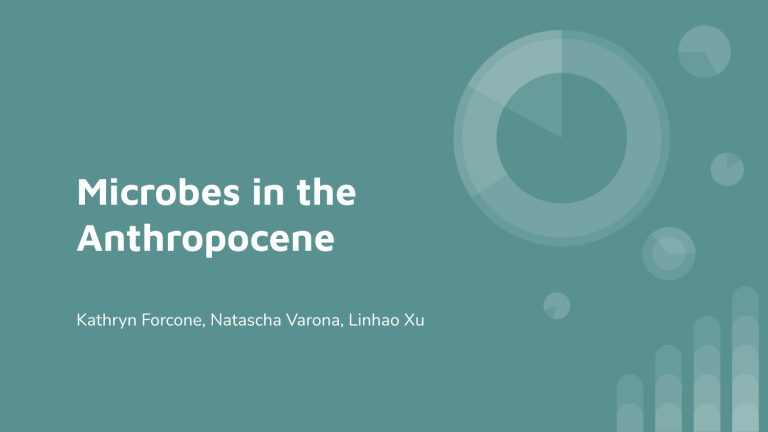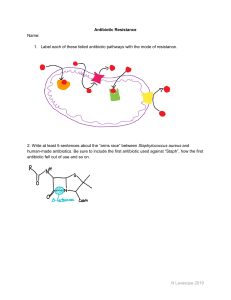
Microbes in the Anthropocene Kathryn Forcone, Natascha Varona, Linhao Xu What are microbes? Bacteria, Fungi, Viruses, Arcea, Protists Some fun facts: ● Some tasks include: nitrogen fixation, nutrient cycling, oxygen synthesis, maintain symbiotic relationships, cause/control of disease ect … ● The microbes on Earth would outnumber all the other flora and fauna on Earth--and outweigh them as well. Your body is composed of 10 trillion human cells, but is host to around 100 trillion bacterial cells. Your body bacteria cells outnumber your own human cells ten to one ● (source: https://microbe.med.umich.edu/some-interesting-facts-missing-microbes) Credit: Silveiralab Microbes in the Anthropocene ● Humans focused on creating sterile areas - disrupting natural populations and inadvertently selecting strains for resistance (Sariola and Gilbert, 2020) ○ ● ● Microbial expansion and virulence, high density urban areas, COVID19 Lateral gene transfer in bacteria causes deadly, rapidly evolving populations Selection by antibiotics, disinfectants, and heavy metals. First discovery and isolation of Penicillin from mold in WWII lead to a ramp-up in global production of antibiotics and decreased mortality from Pneumonia and Staph infections. People then started adding antibiotics to animals to promote faster growth and less disease. Wastewater, Sewage, Hospitals: Bacterial antibiotic resistance ● ● High use of antibiotics contributes to global antibiotic resistant bacteria Hospital wastewater and drinking water help spread drug resistant bacteria into surrounding environments ○ One study from 222 water samples showed all isolated gram-negative bacteria resistant to amoxicillin and ampicillin (Koudokpon et al., 2021) ○ Dispersal is associated with improper waste disposal containing contaminants ○ (Tong et al., 2009) Antibiotic resistance in wastewater from swine farms Wastewater, Sewage, Hospitals: Bacterial antibiotic resistance ● ● Surface soil ecosystems spread antibiotic resistance from ground, surface and wastewater. Anthropogenic contaminants seep into ground Antibiotic resistance genes and mobile genetic elements correlate with heavy metals in the soil (Wang et al., 2021, Zhao et al., 2019) Global warming-Arbuscular mycorrhizal fungi( AMF) Wilson et al. 2016 ● ● ● Arbuscular mycorrhizal fungi (AMF) are plant mutualists in the subphylum Glomeromycotina of Mucoromycota. AMF can increase plant fitness and benefit ecological restoration. However, global warming in the anthropocene directly decreased AMF colonization, which would dampen plant community and ecosystem. Anthropogenic soil degradation-AMF ● ● ● AMF density and richness are lower in degraded areas than in reference sites. Degraded areas have low potassium (K) concentration and high levels of clay and metals. Low AMF compositions in the degraded sites greatly decrease plant fitness. Box-plots of AMF (a) density and (b) richness Coutinho et al. 2019 Anthropogenic pollution (nitrogen deposition)-AMF Allen et al. 2016 ● ● ● AMF colonization is higher in plants grown in non-polluted soils than in polluted areas. Nitrogen deposition decreased AMF activity. Root colonization declined from 45% to 19%, and spore density declined from 105 to 23 spores with elevated N. Microbialization of the oceans Haas et al. 2016 Microbialization of the oceans DDAM model (Dissolved organic carbon, disease, algae, microbes) Anthropogenic agents leading to microbializaition: ● Overfishing ● Agricultural runoff ● Anthropogenic climate change Nelson and Altieri, 2019 Microbialization leads to an increase in bacteriophages infecting microbes (Knowles et al. 2016) What next? Citations Tong, Lei, Ping Li, Yanxin Wang, and Kuanzheng Zhu. 2009. “Analysis of Veterinary Antibiotic Residues in Swine Wastewater and Environmental Water Samples Using Optimized SPE-LC/MS/MS.” Chemosphere 74 (8): 1090–97. https://doi.org/10.1016/j.chemosphere.2008.10.051. Wang, Xiaomin, Bangrui Lan, Hexin Fei, Shanyun Wang, and Guibing Zhu. 2021. “Heavy Metal Could Drive Co-Selection of Antibiotic Resistance in Terrestrial Subsurface Soils.” Journal of Hazardous Materials 411 (June): 124848. https://doi.org/10.1016/j.jhazmat.2020.124848. Zhao, Yi, Tatiana Cocerva, Siobhan Cox, Stacie Tardif, Jian-Qiang Su, Yong-Guan Zhu, and Kristian Koefoed Brandt. 2019. “Evidence for Co-Selection of Antibiotic Resistance Genes and Mobile Genetic Elements in Metal Polluted Urban Soils.” Science of The Total Environment 656 (March): 512–20. https://doi.org/10.1016/j.scitotenv.2018.11.372. Barott, K.L., and Rohwer, F.L. (2012) Unseen players shape benthic competition on coral reefs. Trends Microbiol 20: 621–628 Dinsdale EA, Rohwer F. Fish or germs? Microbial dynamics associated with changing trophic structures on coral reefs. In: Coral Reefs: An Ecosystem in Transition. Springer Netherlands; 2011:231-240. doi:10.1007/978-94-007-0114-4_16 Haas AF, Fairoz MFM, Kelly LW, et al. Global microbialization of coral reefs. Nat Microbiol. 2016;1(6):1-7. doi:10.1038/nmicrobiol.2016.42 Jessen C, Roder C, Villa Lizcano JF, Voolstra CR, Wild C. In-Situ Effects of Simulated Overfishing and Eutrophication on Benthic Coral Reef Algae Growth, Succession, and Composition in the Central Red Sea. Fulton C, ed. PLoS One. 2013;8(6):e66992. doi:10.1371/journal.pone.0066992 Knowles B, Silveira CB, Bailey BA, et al. Lytic to temperate switching of viral communities. Nature. 2016;531(7595):466-470. doi:10.1038/nature17193 Roach TNF, Abieri ML, George EE, et al. Microbial bioenergetics of coral-algal interactions. PeerJ. 2017;2017(6):e3423. doi:10.7717/peerj.3423 Nelson HR, Altieri AH. Oxygen: the universal currency on coral reefs. Coral Reefs. 2019;38(2):177-198. doi:10.1007/s00338-019-01765-0 Silveira CB, Coutinho FH, Cavalcanti GS, et al. Genomic and ecological attributes of marine bacteriophages encoding bacterial virulence genes. BMC Genomics. 2020;21(1):126. doi:10.1186/s12864-020-6523-2 Some interesting facts from "missing Microbes". (n.d.). Retrieved March 30, 2021, from https://microbe.med.umich.edu/some-interesting-facts-missing-microbes



